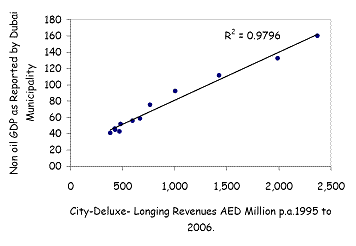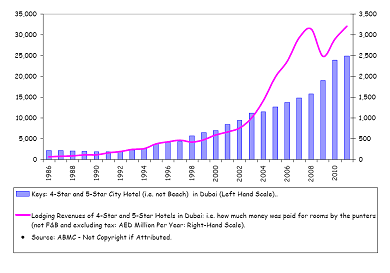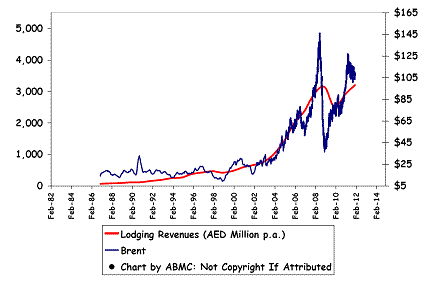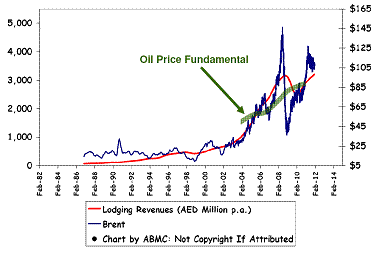The World Economy Stalls; Meanwhile Dubai Bounces Back: So what’s The Secret?
Economics / Economic Recovery Jan 20, 2012 - 08:09 AM GMTBy: Andrew_Butter
 One of the few interesting things about Dubai is that it serves as a barometer for economic activity that happens largely outside of government and outside of OEDC.
One of the few interesting things about Dubai is that it serves as a barometer for economic activity that happens largely outside of government and outside of OEDC.
I’m not talking blood diamonds or drug money, Dubai services a region that extends thousands of miles in all directions and the only thing that happens there that doesn’t happen elsewhere and is “illegal” in many of the places it services, is economic freedom. What’s interesting is that you can measure the pulse the global free-market by measuring the pulse of Dubai.
Although apart from counting cars on the freeway it’s not easy to understand what’s going on. For example in 2007 the GDP for 2006 was reported by the Dubai Municipality to be $46 billion, and yes I did check, I’m looking at a hard-copy right now; but there is no explanation I saw for how come mysteriously that got upwardly revised to $65 billion (i.e. + 40%). The latest number is for 2008…$93 billion; and there are no numbers for 2009 or 2010.
Who knows, perhaps $93 billion for 2008 was the right number? Certainly many people have said that the true size of economic value-added was under-reported if you compare to proxies. It’s hard to know because there is hardly any tax, no exchange control, and companies have no obligation to submit accurate accounts to anyone, and certainly not to their banks…so how do you measure GDP?
Meanwhile life goes on, water keeps coming down the pipes, electricity keeps coming down the wires, internet and phones still work, garbage gets collected, the streets are spotlessly clean, sewage gets treated and recycled to water the parks, gas is cheap, the police are efficient and most of the time they are a lot more charming than the police are in a lot of other places, and the planes still fly in and out on time.
How that gets paid for is another story, so is the mystery of who actually owes the $100 billion people keep talking about, or more to the point, what’s the collateral and if there is any, where is it? Given that entities not “linked” or “related” to Dubai, but that are actually “owned” by the Dubai government, such as the electricity-company and Emirates Airlines, don’t appear to have any problem either servicing or raising debt.
Life is full of mystery, but one of the charms of Dubai is that you don’t get the feeling of the heavy hand of government looking up your skirt and meddling with things they don’t understand. They just make sure everything works, and let the rest just happen; that part’s called free-enterprise; remember that idea?
Anyway, regardless, it’s not hard to work things out; for example a good starting point for a quick navigational fix always used to be hotel statistics because there is a tax like a VAT, and so there is data, and the data used to get aggregated and published quite promptly. Sadly no data has been published since Q3-2008 which was just before the bust, at least none that I could find. But no worries, the hotels exchange data, so with a bit of digging you can find out.
The timeline I like particularly is for 4-Star and 5-Star city hotels, i.e. not on the beach. That roughly disaggregates the tourist market from the business market, and although there is a lot of overlap, it’s a guide; and the best thing is that I got good data going back to 1987.
The reason I like that data is because in the days when I used to stand up in front of people telling fairy-stories about why they should believe my 15-year revenue projections for hotel developments, in Dubai I always used to start off with this graph:

The story went like this, (a) GDP explains total lodging revenue, which makes sense, it’s called “share of pocket”, (b) GDP is quite predictable so you can use that to predict lodging revenues (c) it’s not hard to know roughly how much new supply there will be in the next five years because it takes that long to get from concept to handover for a decent sized hotel, and if you know how you can predict pretty accurately for ten and guess the other five, so (d) divide total revenues by total rooms and you get Revenue per Available Room (REVPAR), and you can adjust that to the market positioning of what you are planning, and (e) BINGO!!…give me the money!!
That works for other places too, try that in Hong Kong or Singapore where they do measure GDP very carefully every quarter, and they do publish their deliberations after 60 days, you get a similar correlation. So presumably that works the other way round, if you know hotel lodging revenues, you can figure out GDP?

If that still works, that says the Dubai economy lost 20% of its value in 2009 compared to 2008, and now it’s bounced back to where it was in 2008 or in other words 30% up in two years, measured in nominal US Dollars of course.
That sounds about right, looking at the other proxies, and OK Dubai’s real estate prices halved in 2009 compared to 2008 and probably a good part of the bubble in economic activity was caused by the bubble in house prices, as it was in America and Europe, just in Dubai that happened over about three years. But real estate prices are still on the floor, a lot of construction stopped and no one is planning new construction, so how come that proxy for economic activity went back up?
Could this be an example of what happens when governments don’t jump in to “save” the system and “manage” things, and just do what governments are supposed to do and simply make sure everything still works, and in particular make sure that the police understand they are servants of the public, not the other way around?
And the result, well if Dubai is any guide, you get a short-sharp pain, anyone who made a stupid investment gets punished and now and then you can spot specks on the horizon in the middle of the desert; which if you get closer you can see are people in dark suits standing looking a bit forlorn, scratching their heads and asking, “is this the collateral”…and low and behold, the free market picks up the slack.
Just for example, I was thinking of buying a house in Europe, I thought, they had a bubble, now they are having a bust, good time to buy. But I noticed the prices are way too high, and I suspect they are being artificially kept up by government and/or central banks, to maintain the status-quo.
Which is all very well if you are one of the lucky 70% of the population that either owns a house or owes the bank a house but they still let you live in it; but I suspect that’s not a recipe for long-term economic prosperity; although clearly I am in a distinct minority on that one.
What next?
The nice thing about a bubble and a bust is that afterwards you get to see where the “fundamental” was, and if you know that you can sometimes make predictions.
That’s the “pebble in the pond” theory which seems to work pretty good although it’s hardly “mainstream” economic theory. There again, there don’t seem to be many mainstream economic theories that can do anything more complicated than predict where the sun will come up tomorrow, and my niece, aged six, can do that.
To illustrate how accurate predictions based on the pebble in the pond idea can be, for example, that predicted the S&P 500 would turn the day it hit 675, then go up to 1200 or thereabouts, then reverse by about 15%, then go up to 1350 or so then reverse by 15% or so again, and then leisurely drift back up again.
Of course that’s not proof of anything; that could have happened if you had employed a chimpanzee to throw darts at a board with random numbers on it ranging from 400 to 4000 which was the range of outcomes predicted by all the best experts in the world over that period.
Sounds easy, but to get the pebble in the pond theory to deliver, you have to do a valuation, and not just a mark-to-market valuation; even a trained chimpanzee can do one of those, you got to figure out the fundamental, or what International Valuation Standards calls Other Than Market Value.
And THEN, you got to test it, by making a prediction in real time, and then see if it worked. If it doesn’t, then you can be pretty sure your valuation model was wrong; if it does then the probability your valuation is sound is equal to the ratio of the range of your prediction, compared to the range of possibilities, which can be approximated by the range of opinions of experts.
So if your prediction says the market will go up, and assuming the experts are divided over whether it will go down, sideways, or up, and it does go up, the probability your valuation model is wrong is One out of Three (33%). Do that two times in a row and its 33% x 33% = 11%...etc. Equally if you say the market will turn on the day it hits 675 , and on that day it ranged from 666 to 686, and the experts were saying (when you made the prediction), anything from 900 to 300, then the probability your valuation model was wrong, is 20/600 = 3.3%.
Worked out that way, the probability of getting the accurate predictions that were made using the pebble in the pond theory on the S&P 500; is one in 35 Million; which is ten times less than the probability used to decide whether you discovered a Higgs Boson or not.
So, perhaps the pebble in the pond theory could be more useful than mainstream, ideas like inflation targeting, the bit-of-froth model that Alan Greenspan was so fond of, and the models Goldman Sachs used to value AAA rated synthetic collateralized debt obligations for their customers? Perhaps not, but if it’s right then that gets you the X on this chart.

Mm… that looks pretty sweet, eyeballing the red-line that says in 2008 about 20% of the economic activity in Dubai was generated by folks who were suffering from the sort of disequilibrium that many people experience when they drink a bottle of vodka.
But how do we know that red-line is correct?
Given that I just got one piece of hard data (the fundamental in 2009), plus some cranky idea about the time to fill in a hole is typically the same as the time it took to dig it, plus I’m guessing the bubble took off in about 2005 or 2006.
So now I’m thinking, what could be driving the economy of Dubai?
Well there is a billboard on the road to Abu Dhabi, partially covered in sand, which says “Where the Vision of Dubai Get’s Built”, but if you get out of your car and climb the hill to look behind, you will see there is just a huge expanse of sand with an occasional lost-suit wandering around, so I’m thinking; perhaps that’s not it?
Personally I put the driver of Dubai’s economy down to the limited instruction set line of the much loved and sadly departed H.H. Sheikh Rashid Al Maktoum….”I will build the infrastructure and the rest will follow”.
Which sounds a bit like something Milton Friedman or Ayn Rand might have said, except of course, (a) Rashid said it first, and (b) Rand also said that all Arabs (Muslims) are “totally primitive uncivilized racist savages”.
http://www.youtube.com/watch?v=2uHSv1asFvU&feature=related
Oh well, perhaps there are things that can be learned from totally primitive uncivilized racist savages?
If Rashid was right, what drives the “rest”?
How about oil perhaps? Given that Dubai is a service economy that services a region awash with oil, even though it has none to speak of (about $2 billion a year worth).
This is a plot of 4-Star and 5-Star city-hotel lodging revenues, which as was explained, might just be a decent proxy for GDP, compared to oil prices:

Well that’s interesting, kind of puts the idea of the “fundamental” being a straight line to bed, that says the bubble wasn’t caused by property speculation, but by oil prices going crazy, and the oil prices bust, and well, so did Dubai’s economy.
What intriguing there is the dynamics might be an example about how bubbles spread, there was a bubble in oil prices, everyone who made money out of that started spending money in Dubai, the banks thought “WOW look at all that money, we can’t loose here”, and the hot money got put down buying real estate, and then the price of oil went down, and Dubai real estate prices went down, and the economy went down.
Another intriguing thing is that on that chart, the “fundamental” price for oil; (according to the pebble in the pond theory), crossed the Lodging Revenues line, at about the lodging revenues fundamental.
If you take the red line from this chart:

http://www.marketoracle.co.uk/Article24849.html
And paste it on the other chart, you get this:

Well that fits at least on the two fundamentals, what that says is that regardless of any oil-bubble induced bubble-and-pops, lodging revenues in Dubai are likely to track the oil price fundamental.
The Future?
Perhaps the world is increasingly getting divided into the parts that have oil, or who alternatively make money out of the parts that have oil (like Dubai), and the parts that have to borrow money to import oil?
And the “have-nots” over the past few years have re-aligned their economies to a system where the process of borrowing money and not paying it back has been refined into an art-form; that has taken over from the old-fashioned system of creating real economic value-added, supported by banking systems based on lending money against carefully valued collateral in case the people they lend money too don’t pay it back, which is a really novel idea, and is certainly not “mainstream” these days.
Perhaps, just around the corner there will be that magic discovery which will turn the tide and ensure that never-again do decent civilized people have to borrow money to pay totally primitive uncivilized racist savages so they can drive to work.
But there again, that’s what everyone was saying twenty years ago, now the quandary is what is the real “fundamental” for the price of oil?
Is it the price that the parts of the world that have to borrow money to buy it, and can just about afford to pay 3.3% of their GDP every year for that commodity, or does the recent volatility in the price suggest a new paradigm is emerging?
One where the “Other Than Market Value” is not what the customers can afford to pay, but the cost to discover, and bring to market, an equal supply of oil as has been discovered so far? I’m beginning to suspect the time oil gets priced on it’s replacement value (what it would cost to get hold of oil if all the existing producers decided to leave their oil in the ground waiting for the price to go up), that’s because the down-swing in oil prices predicted by the pebble in the pond theory, didn’t happen.
Right now I’m beginning to suspect that the OIK part of my oil valuation model might be wrong, and that there is starting to be either a “holding back” or perhaps the numbers for world GDP are counting less of the value-added that gets created outside the view of government?
Meanwhile, for now, the Saudis play the role of “fairy-godmother-of last-resort”, keeping things oiled so as not to stall the world economy; but no one knows how long that will last, before they start to run out, and I noticed they recently decided that $100 was “Fair Value”, up from $75 two years ago.
But regardless of whatever anyone says about what the GDP of Dubai is, I expect city hotel lodging revenues, will follow the path of the oil-price fundamental.
By Andrew Butter
Twenty years doing market analysis and valuations for investors in the Middle East, USA, and Europe. Ex-Toxic-Asset assembly-line worker; lives in Dubai.
© 2012 Copyright Andrew Butter- All Rights Reserved
Disclaimer: The above is a matter of opinion provided for general information purposes only and is not intended as investment advice. Information and analysis above are derived from sources and utilising methods believed to be reliable, but we cannot accept responsibility for any losses you may incur as a result of this analysis. Individuals should consult with their personal financial advisors.
Andrew Butter Archive |
© 2005-2022 http://www.MarketOracle.co.uk - The Market Oracle is a FREE Daily Financial Markets Analysis & Forecasting online publication.



